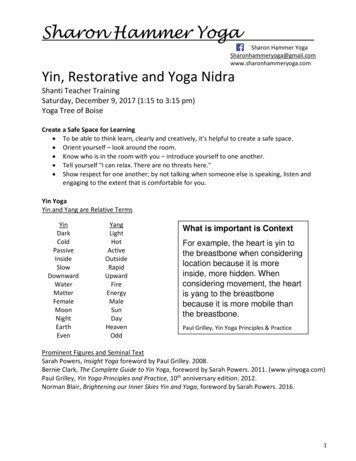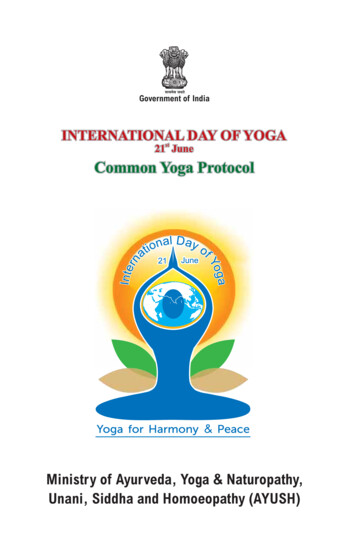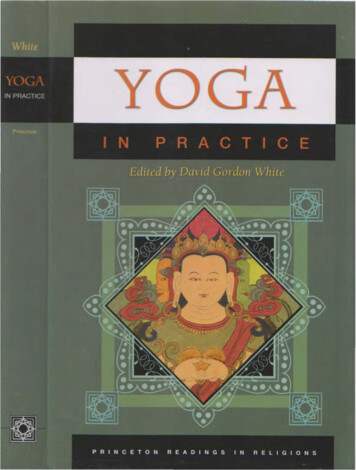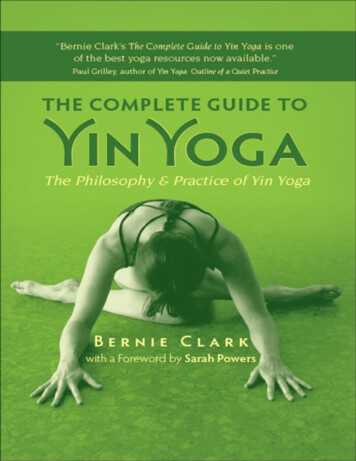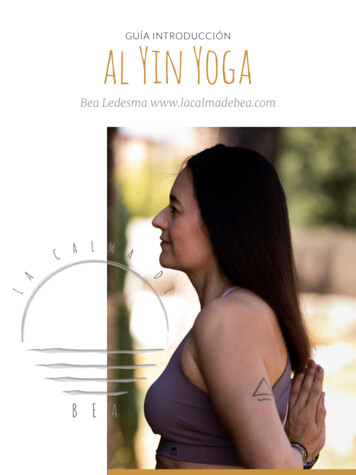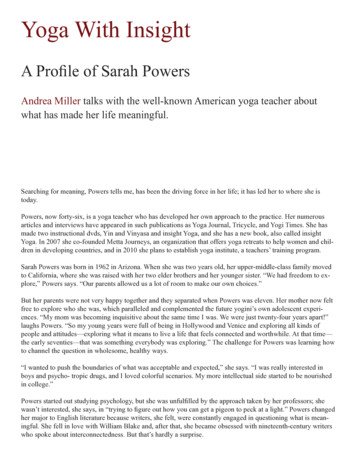
Transcription
Yoga With InsightA Profile of Sarah PowersAndrea Miller talks with the well-known American yoga teacher aboutwhat has made her life meaningful.Searching for meaning, Powers tells me, has been the driving force in her life; it has led her to where she istoday.Powers, now forty-six, is a yoga teacher who has developed her own approach to the practice. Her numerousarticles and interviews have appeared in such publications as Yoga Journal, Tricycle, and Yogi Times. She hasmade two instructional dvds, Yin and Vinyasa and insight Yoga, and she has a new book, also called insightYoga. In 2007 she co-founded Metta Journeys, an organization that offers yoga retreats to help women and children in developing countries, and in 2010 she plans to establish yoga institute, a teachers’ training program.Sarah Powers was born in 1962 in Arizona. When she was two years old, her upper-middle-class family movedto California, where she was raised with her two elder brothers and her younger sister. “We had freedom to explore,” Powers says. “Our parents allowed us a lot of room to make our own choices.”But her parents were not very happy together and they separated when Powers was eleven. Her mother now feltfree to explore who she was, which paralleled and complemented the future yogini’s own adolescent experiences. “My mom was becoming inquisitive about the same time I was. We were just twenty-four years apart!”laughs Powers. “So my young years were full of being in Hollywood and Venice and exploring all kinds ofpeople and attitudes—exploring what it means to live a life that feels connected and worthwhile. At that time—the early seventies—that was something everybody was exploring.” The challenge for Powers was learning howto channel the question in wholesome, healthy ways.“I wanted to push the boundaries of what was acceptable and expected,” she says. “I was really interested inboys and psycho- tropic drugs, and I loved colorful scenarios. My more intellectual side started to be nourishedin college.”Powers started out studying psychology, but she was unfulfilled by the approach taken by her professors; shewasn’t interested, she says, in “trying to figure out how you can get a pigeon to peck at a light.” Powers changedher major to English literature because writers, she felt, were constantly engaged in questioning what is meaningful. She fell in love with William Blake and, after that, she became obsessed with nineteenth-century writerswho spoke about interconnectedness. But that’s hardly a surprise.
Interconnection, integration, and synthesis, after all, are key concepts in her life and are today the hallmark ofinsight yoga, her yoga style, which weaves together taoism, yoga, and buddhism.Meditation continually helps me discover greater potential for seeing andlistening in a way that’s more aligned with deeper truths, rather than myconditioning. That informs every moment, so my yoga practice is muchricher.“I now see how each lineage is a transparent map, which when placed on top of the others widens my ability tochart a course through my inner labyrinth,” writes Powers in insight Yoga. “The various traditions act as guidesrather than absolute authorities.” In our interview, she adds that her meditation practice doesn’t simply enhanceher yoga practice; to her, it is yoga practice. They are integral paths of self-discovery that are not separate.As for the Taoist element in insight yoga, it is primarily Chinese medicine—the healing branch of the tradition.“I’ve used western medicine for surgery and been very thankful that it was there,” Powers says. “but westernmedicine tends to work more with suppressing symptoms through the use of some kind of invasive agent, andChinese medicine tends to have a more holistic view.”According to traditional Chinese thought, everything in the universe, both organic and inorganic, is composedof a vital essence or energy called chi, and this chi flows through the human body along certain invisible pathways called meridians. For good health, chi, which moistens the joints and connects the interior and the exteriorof the body, must have proper strength and flow. The concept of chi can be compared to the prana of buddhismand hinduism, and the concept of meridians to the nadis.Powers has studied meridian theory with Dr. Hiroshi Motoyama and his student, yoga teacher Paul Grilley, andshe has learned from them that there are three ways one can positively influence the flow of chi while practicing yoga: putting the body into particular shapes to pull and pressurize tissues; manipulating the breath throughpranayama, yogic breathing; and focusing the mind on our movements.She learned what is called yin yoga from Grilley. Yin and yang are the two ways that chi manifests. whenwe refer to something as yin, we mean it’s cooler, less mobile, more hidden, and feminine. When we refer tosomething as yang, we mean it’s warmer, more pliant, superficial, and masculine. yin and yang are relationalterms. That is, neither exists in a vacuum, but one or the other is dominant at any given time. Yin yoga is a quietpractice that emphasizes holding poses for long periods in order to work with one’s deep tissues—the bones andligaments. Yang yoga is more active. It involves rhythmic movement and engaging the muscles.Powers incorporates both yin yoga and yang yoga in her practice. Both are important, she believes; yin yogahelps us relax when we’re under stress, and yang yoga invigorates us if we lead sedentary lives. Powers workswith meridians when doing both yin and yang styles. When she was first studying Chinese medicine, she wouldlook at diagrams showing where in the body the meridians begin and end, and how they flow. Then she’d practice a pose to try to feel which meridian was influenced—which aspect of her physical or emotional health. “Itbecame a piecing together puzzle,” she says. In the foreword of insight Yoga, Grilley writes, “Sarah employstaoist terms, buddhist terms, and Sanskrit terms, depending on which most clearly and succinctly describe theunderlying ideas. It is a historical accident that Chinese Taoists elaborated certain energetic ideas better thanothers, that the Tibetan Buddhists elaborated subtler mental processes, and that the Sanskrit peoples elaborateddeeper inner and outer cosmologies. All these systems describe aspects of reality that were most pertinent tothem at the time of their creation.
“Sarah’s book,” Grilley writes, “is a yoga book. It is not merely taoist or buddhist or Sanskrit. It embodies whatthe term yoga has historically stood for—a system of practices that cultivates all levels of a human being.”Sarah and Ty Powers met when she was working at a restaurant and he came in for breakfast. That led to a fewdates, but, she says, “we were in different psychological spheres. I was eighteen and he was twenty-seven. I wasabout to move to boulder to go to college, whereas he was an executive at CBS television and a classical guitarist who collected wine.”Powers went to boulder as planned. After that, she would occasionally clean out her wallet and find the crumpled paper she had with his number on it. But instead of throwing it away, she’d just shove it deeper down intothe folds of her wallet. He was interesting, she thought. Maybe someday she’d want to phone him again. Andthat is exactly what she did a year and a half later when she moved back to Los Angeles so she could transfer toUCLA.Little did Powers know that at the exact moment she called, he was on the couch breaking up with the womanhe’d been seeing since Powers had left for college. When he picked up the phone and said, “yes, Sarah, I remember you,” his girlfriend jumped up and ran out of the house. Later that day, the girlfriend told him she’d hada dream he would end up with a Sarah.“He was rude to me on the phone in deference to her,” Powers says. “He said, ‘OK, what’s your number?’ And,as I rattled it off, I thought, he doesn’t have a pen. He’ll never call back. I was embarrassed for calling.”Yet, three weeks later, he did phone. He had memorized the number. They met for lunch, and they’ve beentogether ever since. “I had a number of years to go in college,” Powers said, “and he was patient with me whileI had to say no to social events because I was studying. Ty is enthusiastic without needing a reason, just thepoignancy of being alive. He’s someone who is very inquisitive.“Ty introduced me to opening the curtain and looking past what seems obvious. He had read a lot of metaphysical material. I’d say, how do you know that stuff is true? And he’d say, I don’t but I’m willing to question anddiscover for myself what’s true. Then he’d say, you might want to read this or that, and I’d start to explore. Wehad such juicy dialogues about the meaning of life.”The couple wed when Powers was twenty-three and her mother was expecting the child of a younger man. “Mymom,” quips Powers, “was the forty-seven-year-old, pregnant, unmarried mother-of- the-bride.” Although herfather, didn’t attend the wedding, about five years after the wedding, father and daughter reconciled their differences, and now have a loving respect for each other. Powers’ mother was a Buddhist then, and now she hasfound a spiritual teacher from the Hindu tradition and has been studying with him for the past twelve years.“She spends most of her time with that practice,” Powers says. “She’s an ascetic older woman now.”After the wedding, Powers began her masters in Transpersonal psychology. “The program was the synthesis of spiritual development with psychological healing and growth,” she says. “We were exposed to writersfrom all different traditions, including many who had integrated psychology with eastern practices. I read JackKornfield’s and Frances Vaughn’s work, and I felt they were so articulate about their own psychology—boththe beautiful, insightful sides and the broken aspects. The psychological training they’d had in university gavethem language and helped them help other people, but the practices forged the pathways.” On an intellectuallevel, this is when Powers became curious about Buddhist meditation and how it might help her to heal her ownpsychological wounds.The masters program also exposed Powers to the mind-body connection. She was required to learn a physicaldiscipline with spiritual roots, she chose yoga because she’d practiced it a few times, using a book her brotherhad given her. She assumed that, being young and athletic, yoga would come easily. Wrong—it was rigorous,
both mentally and physically. “I was brought down to my blood, sweat, and tears nature,” Powers says, “andhalfway through I decided yoga wasn’t for me.” But savasana, the motionless “corpse pose” that concludesmost yoga sessions, changed her mind. She says that during this “nap time” she experienced an unusual peace,which she pinpointed as an absence of longing.When we have a body-centered practice, the body is our most intimateguide. We ask, where am I feeling tension or stuck-ness? And instead ofassuming we shouldn’t be feel- ing what we’re feeling, we hold the dissonance.Was clarity with joy underneath, and she decided she had to come back to yoga—that it would be hard but harddidn’t mean bad. As she got deeper into the practice, Powers considered doing her thesis on how yoga mighthave different psychological effects on different people, and she was in the process of interviewing teacherswhen one asked why she had chosen this topic. She responded that it was to fulfill her program requirements,but she knew this was only the surface answer. Afterwards, she took the question deeper: Why do I really wantto do this kind of study? How will it affect my practice and life?Powers realized that she was trying to articulate the merits of spirituality so she’d be armed to discuss the matter with someone like her father—someone, she says, who was good at arguing. Powers called the school andsaid she wasn’t going to complete the program. “I really didn’t want to intellectualize my practice,” she says. “Iwanted it to be more self-investigatory.”So she dedicated herself to self-study, to exploring a wide range of traditions.Now her crisis of meaning changed its flavor. No longer simply trying to define “meaningful,” she was askingwhat it felt like to embody it.The first person Powers taught yoga to was her husband, and it is yoga that has enabled the couple to becomebody-centered, meaning they’ve made the body into an ally. “When we’re not body-centered, we act out fromreactivity and we’re at the mercy of whatever habits we have for coping with discomfort,” Powers explains.“But when we have a body-centered practice, the body is our most intimate guide. Prior trauma that’s beingreactivated doesn’t become another layer of submerged material we can’t deal with; rather it becomes an addeddoorway into the body. We ask, where am I feeling tension or stuckness and instead of assuming we shouldn’tbe feeling what we’re feeling, we hold the dissonance.”That said, a practice that’s only, or even mostly, body-based does have potential pitfalls. “There is a tendency,”Powers warns, “to do body practices to stay thin, have tight buns, or to get attention for doing certain postures—egocentric motivations stemming from not knowing oneself truly.” Yet yoga focused only on shape serves apurpose for a certain level of development, as it tends to eventually change the person doing it, even thoughthey may or may not know they’re being changed.“Coming through the doorway of the body,” she says, “people eventually realize they have a mind that needsattention and, coming through the doorway of the mind, they eventually realize they have a body that is going tobe either an obstacle or a support. Both directions point to their opposite.”As for her personal path of discovery, bringing together her metaphysical readings and yoga as a physical discipline seemed like an easier combination than sitting down and facing her own mind. “While doing asana,” she
says, “I was readying myself for meditation.” When she felt the time was right, Powers did a retreat with students of the Vipassana meditation teacher Goenka.In the same way she’d been surprised by how difficult yoga was, Powers now had to come to grips with howdifficult long meditation sessions were. Indeed, she found this first Goenka-style retreat one of the most challenging things she’d ever done, not because her mind was distracted—she’d expected that—but because thepractice was so physically arduous. She realized that her yoga practice had been oriented around feeling comfortable. She’d find a pose and, as soon as it became uncomfortable, she’d move to the next. To sit for hours,without trying to improve the posture through movement or visualization was a whole different matter. And itwas life-changing.Powers did three more Goenka-style retreats; she did Vipassana retreats with Spirit rock teachers, and she wentto Burma to do a retreat there. Eventually, she delved into Zen and Tibetan Buddhism. “My meditation practicecontinually helps me discover greater potential for seeing and listening in a way that’s more aligned with deepertruths, rather than my conditioning,” Powers says. “That seeing and listening informs every moment, so myyoga practice is much richer.”While Powers was developing her practice, she and her husband were also raising their daughter, Imani Jade,who is now sixteen. “I wasn’t willing to spend too much time away from her,” Powers says. “Ty and I werehome-schooling her, so we would relieve each other for short periods to go off on retreat.” One of the reasonsthe couple decided on home schooling was because, when Imani Jade was five, they started traveling in order togive yoga workshops—something they continue doing today throughout the United States, Asia, and Europe.Until Imani Jade was fifteen, the family went everywhere together. In hotel rooms, trains, planes, and waitingrooms, they’d read and discuss. Then Imani Jade would write a paper. To allow her to develop her social skills,the family tried to spend one season a year at home in California. Imani Jade would take classes at junior college (starting at age twelve) or she’d be in a play, or take dance classes. With her education tailored to her paceand interests, Imani Jade whizzed through her elementary and secondary education, and is currently studyinghistory and dance at a college in the New York area.“Ty and I are all alone again, like we were before we had her,” Powers says, her voice carrying a hint of emptynest syndrome. The couple has been together for twenty- seven years. They frequently co-teach yoga retreats,and Ty Powers is their manager.“I’m curious,” I say, “about those juicy conversations you two have about meaning. What’s Ty’s take?”“It’s constantly evolving,” Powers tells me. “Yet I’d say what’s meaningful to him is constantly broadening hiscapacity for inclusiveness. It’s having an uncompromising love and compassion for family— no matter howthey are—and extending that love to the human family.”“And what about you?” I ask. “What do you think makes life meaningful?”“One of the reasons we’ve been together so long is that we’re aligned. For me, what’s meaningful is interconnectedness. Where do I feel split, whether it’s within me, in my psyche, or between me and an event or a person? What’s meaningful is the pain and the suffering of that, and seeing the healing.“What’s meaningful,” Powers says, “is discovering a capacity for renewed freshness and continual insight.” For resources and further reading on Yoga and Buddhism, go to www.shambhalasun.com.
Yin yoga is a quiet practice that emphasizes holding poses for long periods in order to work with one’s deep tissues—the bones and ligaments. Yang yoga is more active. It involves rhythmic movement and engaging the muscles. Powers incorporates both yin yoga and yang yoga in her practice. Bo
